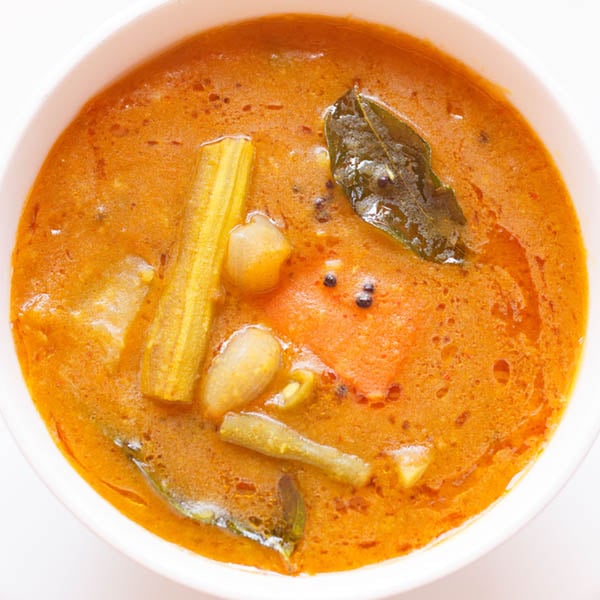Sambar Recipe | Homemade Sambar
4.9
(100)
Your folders
Your folders
Prep Time: 15 minutes
Cook Time: 30 minutes
Total: 45 minutes
Servings: 4
Author : Dassana Amit

Ingredients
Export 16 ingredients for grocery delivery
Instructions
Step 1
Soak the tamarind in hot water for 20 to 30 minutes.
Step 2
Once the tamarind gets soft, then squeeze the tamarind in the water itself. Discard the strained tamarind and keep the tamarind pulp aside.
Step 3
Rinse tuvar dal a couple of times in water.
Step 4
Drain all the water and add the dal in a 2 litre pressure cooker. Also add ¼ teaspoon turmeric powder.
Step 5
Add 1.5 to 1.75 cups water and mix. Cover and pressure cook dal for 7 to 8 whistles or 9 to 10 minutes on medium heat.
Step 6
When the pressure settles down on its own, open the lid and check the dal. The dal should be completely cooked and mushy.
Step 7
Mash the dal with a spoon or wired whisk. Cover and keep aside. You can see the consistency of dal in the pic below.
Step 8
When the dal is pressure cooking – rinse, peel and chop the vegetables.
Step 9
Take the chopped vegetables in a pan or pot. Also add 6 to 7 pearl onions or 1 small to medium onion (thickly sliced) and 1 small to medium tomato (quartered).
Step 10
Sprinkle turmeric powder, kashmiri red chilli powder and salt as per taste. Adding kashmiri red chili powder is optional and can be skipped.
Step 11
Add 1.5 to 2 cups water and stir.
Step 12
Keep the pan on a stove top and begin to cook vegetables on a medium-low to medium flame. In between do check when the vegetables are cooking.
Step 13
Cook till the vegetables are almost done. Ensure that you don’t over cook the vegetables.
Step 14
Once the vegetables are almost cooked, then add the tamarind pulp and 1 to 1.5 tablespoons sambar powder. Mix well.
Step 15
Add the mashed dal. Mix again very well.
Step 16
Simmer on a medium-low heat till the sambar comes to a boil.
Step 17
You will see a frothy layer on top when the sambar begins boiling. At this step switch off the heat. Cover and set aside.
Step 18
In a small pan or tadka pan, heat 2 tablespoons gingelly oil. Add ½ tsp mustard seeds.
Step 19
Let the mustard seeds crackle.
Step 20
Then add 1 to 2 dry red chillies (halved and seeds removed).
Step 21
Immediately add 10 to 12 curry leaves, 5 to 6 methi seeds and 2 pinches of asafoetida (hing). Be careful as the oil splutters while adding curry leaves.
Step 22
Fry them till the red chilies change color and curry leaves become crisp.
Step 23
Immediately add this tempering mixture in the hot sambar.
Step 24
Cover the pan with its lid for 4 to 5 minutes, so that the aroma and flavors from the tempering mixture gets infused with the sambar.
Step 25
Serve sambar hot. You can garnish it with a few coriander leaves if you prefer. It can also be served with steamed rice, idli, dosa, medu vada or uttapam.
Step 26
Serve sambar with steamed rice, idli, dosa or medu vadai or uttapam.
Step 27
Vary the consistency of sambar keeping in mind the dish you want to serve it with. Example - a medium to slightly thin sambar is served with idli, dosa and medu vada. Sambar with a medium to thick consistency is served with steamed rice.
Step 28
Store any leftovers in the refrigerator for a day only. Note that the consistency will thicken after refrigeration. Add some water and mix to get your desired consistency while reheating in a pan.